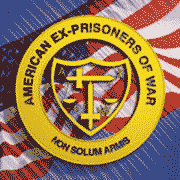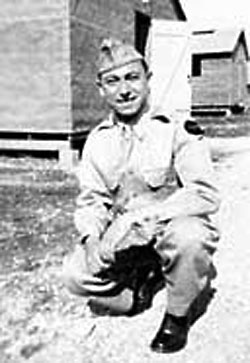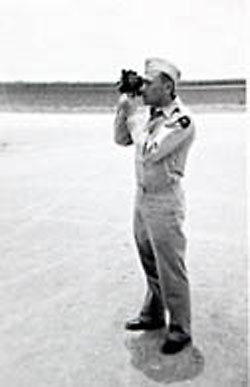
Established April 14, 1942
 |
American Ex-Prisoners of War
A not-for-profit, Congressionally-chartered veterans’ service organization advocating for former prisoners of war and their families.
Established April 14, 1942 |


Navigation School April 15,1943
|

Navigation School May 16, 1943
|
|
| Last Name | First Name, Middle Init. | Nickname |
| Spouse | City | State, Zip |
| Conflict — Theatre | Branch of Service | Unit: |
| Military Job | Date Captured | Where Captured |
| Age at Capture | Time Interned | Camps |
| Date Liberated | Medals Received | |
| After the War ... | ||
From there he was sent to the West Coast to afford protection to the Pacific shore. At the same time he attended radio school and became competent in that instrument as well. After testing and a transfer to Ft. Lewis, he was assigned to the Air Force and Ellington Field, TX, for training as a navigator.
He was then sent to Walla Walla, WA where combat training on gunnery systems was yet another aspect of training for crew members of the B-17 "Flying Fortress."
"Our shipment to the combat area took a tortuous turn. Instead of flying, we convoyed through submarine-infested waters. From there we were flown to a number of spots until we reached Tunis in North Africa. There, we joined others, living in tents, as part of the 15th AF, 301st Bomb Group, 352nd Squadron.
"A typical eight-hour mission comprised three B-17s fully loaded. Some never made it back, some never even made it to the targets. Some made it home on two engines. The Flying Fortress was a marvel of engineering!
"One of our gunners was badly wounded on one mission, . My jacket helped keep him warm, and alive, in those freezing temperatures. For me, it meant a stay in a field hospital for two weeks.
"On Dec. 1943 one of our missions was to cross the Adriatic Sea through unexpected weather. The group began to break up as we searched for the target. We were down to two engines and little oxygen when we finally bombed our target. I could only estimate our position, and we soon began falling behind the other planes.
"A break in the clouds revealed snow-capped mountains, indicating that we were over Yugoslavia, and I charted a course home based on that. My co-pilot came to check my work. He was so concerned he told me that he wouldn't let me in the life raft if I had made an error. As it was, we were the only plane to make it back. The co-pilot begged for forgiveness and asked that I serve with him from then on.
"But on Feb 24, 1944, our luck did not hold. On the way to Central Europe, we encountered enemy fighters, and since we were flying in the outer flank, it was our job to protect the group from the enemy fighter. But they were too over whelming for us. In short order, our B-17 was out of control and burning, the pilot gave us the signal to bail out at 20,000 feet.
"I was wounded slightly from fragmentation bursts, and the parachute harness nearly slipped off over my head during the descent but I managed to pull the rip cord and float down safely into a snowy farm field. Shortly after, the enemy home guard had surrounded me, and I wound up a POW for 15 months at Stalag Luft 1 in Barth, Germany.
"The last days of my interment were particularly nerve-wracking. Hitler had ordered that Jewish American POWs be segregated and made part of his 'Final Solution.' It was a race between fate and the Russian advance. Happily, I am here today to tell you the end of my story. A short time after the Russians freed us and fed us, General Eisenhower had us flown out from a captured air field to Paris. In B-17s."